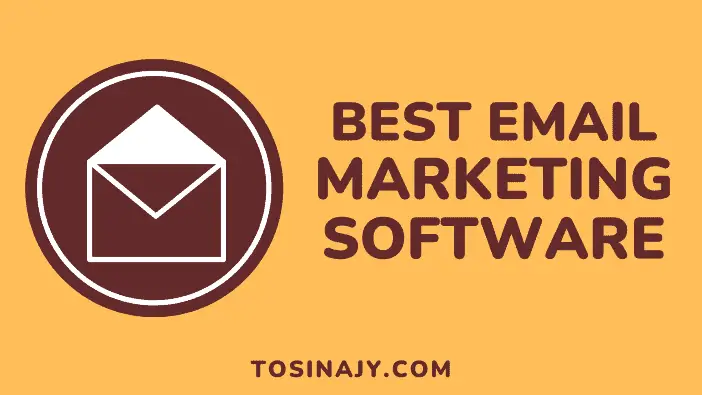Email marketing is a strategy that is employed in digital marketing that involves sending emails to prospects and customers alike. Eventually, effective marketing software or platform converts prospects into customers.
Among marketing channels, email marketing software gives one the highest return on investment (ROI) which is a stunning 4,400%. That is, one gets $44 for every $1 spent. Isn’t that cool!
In addition, there are 1.5 billion active Gmail users and all of them could be possible customers.
The best email marketing services, software, and platforms all have different features and price plans.
Most of these tools are great but you just have to find the best one for you.
In this guide, I have listed the best email marketing software and platforms. It will ultimately help you pick the most appropriate one for you, and save the most money. Who doesn’t want to save their money?
Also, check out how to start a blog business if you want to make money blogging.
What is the best email marketing software?
When choosing an email marketing software consider the following; pricing, technical support, template designs, ease of use, deliverability, automation, reliability, integrations, and any additional features that you may need.
The best email marketing software should allow you to design emails with ease, divide your list, personalize your messaging, and view analytics reports. And they should most importantly get to users’ primary inboxes.
In the end, email marketing is all about sending to the right user, the right message, at the right time.
Below are my picks for the best email marketing software and services to try this year:
1. GetResponse
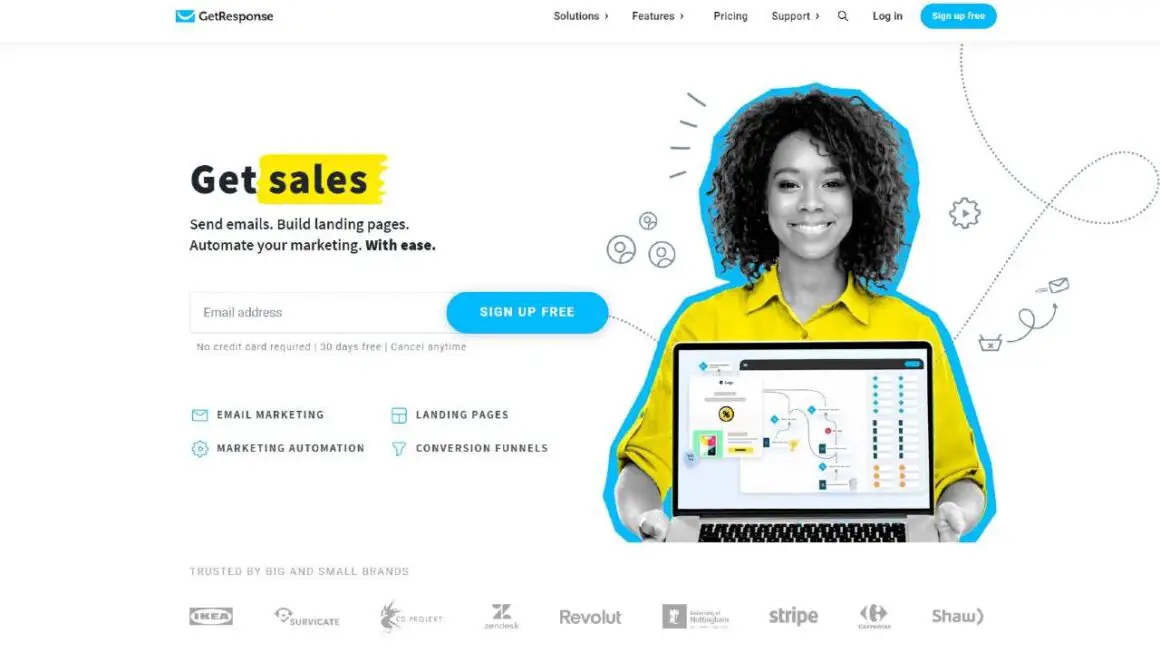
GetResponse is an all-in-one online marketing platform to build your business. They offer various functions like email marketing campaigns, high-converting landing pages, and webinar software to help your marketing efforts.
The feature worthy of note here is Autofunnel – a tool with 30+ ready-made landing pages, email templates, and sequences to trigger sales. You can choose your end goals.
Whether you want to drive lead generation, webinar registrations, or product sales, Autofunnel is the answer. They are optimized to take care of your email list and maximize your funnel’s conversion rates.
A drawback is that some of their 500 templates look a bit outdated, and they have middle-of-the-pack deliverability compared to others on this list.
However, one of GetResponse’s greatest strengths is its smart automation tools. Using these features, you create numerous advanced conditions to divide your lists automatically. Their drag-and-drop builder is also very intuitive and makes designing high-quality emails a piece of cake.
Generally, GetResponse is one of the best email marketing tools to create automated sales funnels and landing pages. You can start with a 30-day free trial and later upgrade to their $15/month Basic Plan if you are interested. Annual plans also save you between 18 and 30%.
2. HubSpot
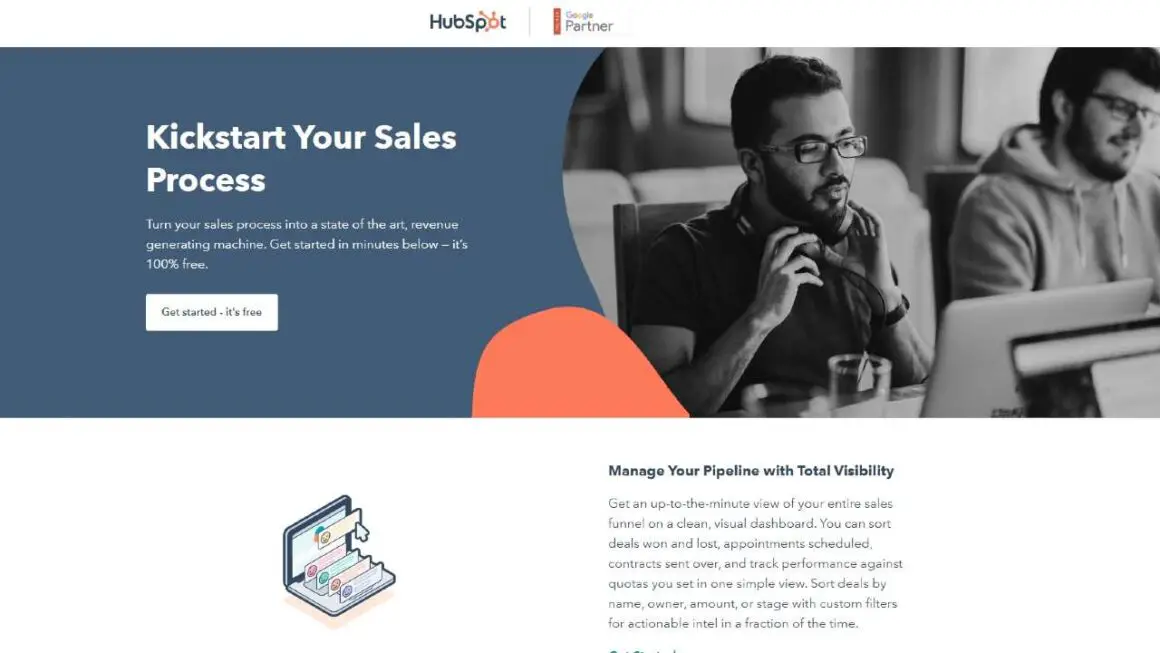
The most integrated marketing package on the market has to be HubSpot. Using their email marketing software is one of the simplest ways to design, optimize, and send fantastic looking emails. They provide a lot of custom features and you can pick and plan and upgrade whether you are a small business or large enterprise.
When creating an email, you either use one of their email templates or start from scratch. These templates allow you to add text, buttons, dividers, images, and all different kinds of assets and layouts.
You will discover that their email editor is the easiest to use on the market. It is way quicker and more user-friendly than other tools on this list.
Once you’re satisfied with your email design, preview it based on different recipients, devices, or email clients like Gmail, Apple Mail, and Office 365.
This tool is super useful. Email subject lines, preview text, and the content itself sometimes vary based on your email client. These previews ensure your emails fit into any specific inbox.
Customization is another advantage of using HubSpot. Like standard tools, you customize content based on common merge tags like the recipient’s first name. HubSpot takes it a step further than other email marketing platforms.
Also, personalized content based on a user’s device, list segment, and geographic location is another feature offered by HubSpot. In addition, you can A/B test your subject lines and content to make sure you maximize your email open rates and click rates.
Next, when you’re ready to send and publish your email, you can use their Smart Send functionality. This feature allows you to confirm your send time to maximize engagement.
After sending your email, the next action is to view your metrics. The HubSpot analytics dashboard gives you data on your opens and clicks, including unique information on the amount of time spent viewing your email.
For example, you may see that subscribers are merely viewing your emails for a short time. This data in turn helps you discern which types of email content need to be worked on and improved.
Consistently striking users’ inboxes is another benefit of using HubSpot. They have a healthy rate of email deliverability which is almost 100%. These significant numbers are due to proper domain validation settings with DKIM and SPF records, plus the ability to thoroughly preview and test emails.
HubSpot’s email marketing platform is just one part of their product. The actual benefits are embedded in their Marketing Hub Starter Package.
This marketing platform includes email marketing and everything else that you can think of to support your marketing and sales efforts:
- Phone and email support
- Full-featured CRM
- Gmail extensions to track email sends and automate outreach
- Automated sequences
- Mobile optimization
- Personal calendar to schedule appointments
- Form builders
- Inbound lead, email, and ad analytics
HubSpot perfectly aligns your inbound and outbound marketing in the most efficient way possible.
I suggest you get started for free, then upgrade to their Marketing Hub Starter Package for $50/month.
3. Moosend
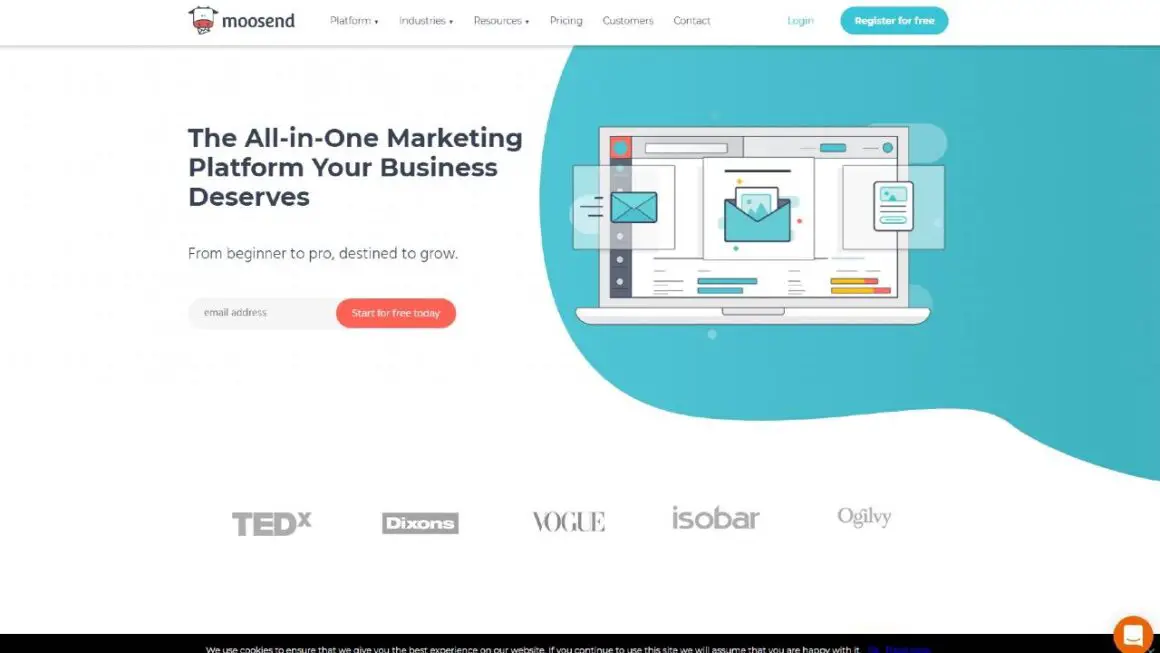
Moosend is an email automation tool that assists you to build your email list, personalize your messages, and automate tasks so you can concentrate on customer relationships.
In-built drag-and-drop email templates are available in their campaign builder. This tool lets you add images, social icons, text blocks, and more to your emails. They have a massive collection of email templates with different layouts that are responsive and look great on mobile desktop.
The unique area that makes Moosend stand out is the automation features. Using their pre-built automation templates (also known as “Recipes”), you can automate messages via upsells, customer engagement, and customer loyalty. Every single automation has three main components: the triggers, control steps, and actions. Combining these 3 components can help filter email list segments and send sequences when your specified actions occur.
Some other key Moosend features include:
- Customer support is included in each paid plan. They also offer video tutorials.
- Creation of custom webpages with email sign-up forms in order to increase conversions.
- Ability to design and create custom forms to let visitors subscribe to your email list.
- Ability to segment your list based on customer behavior like engagement metrics, abandoned cart emails, and more.
- Analytics tools that provide a bird’s eye view of all of your important email metrics.
- The automation of workflows: These templates let you personalize your emails and nurture customer relationships with ease.
The pricing for Moosend all depends on the number of subscribers in your email list. There is a free plan for users with under 1,000 subscribers and this includes sign-up forms, reporting, and the ability to send unlimited emails.
Moosend paid plans starts at $8 per month and increase with the number of subscribers. Every paid plan comes with access to landing pages, phone support, transactional emails, and SMTP servers. Also, their enterprise plan provides an account manager, migration and onboarding support, and Security Assertion Markup Language (SAML).
If you’re looking for advanced email automation tools, Moosend is worth a try.
4. Pabbly Email Marketing
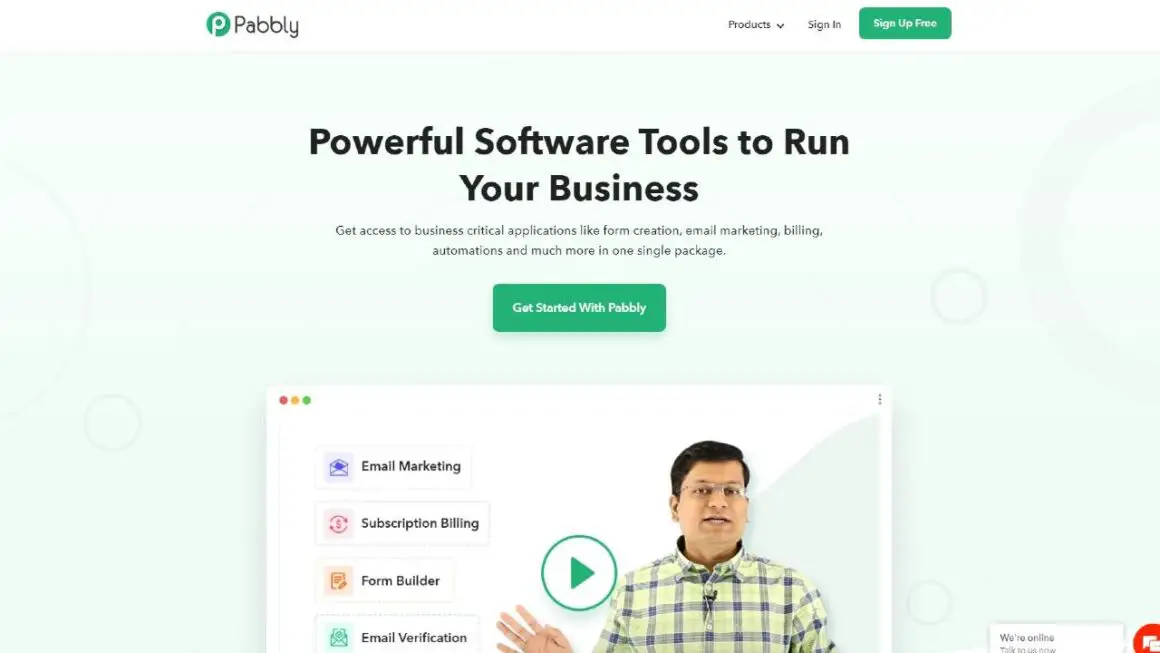
Pabbly is an online platform, which provides a full-service suite of marketing tools for email marketing, online form building, subscription billing, and email list cleaning.
Pabbly’s email marketing service doesn’t limit you on features like marketing automation, list management, segmentation of subscribers, autoresponder emails, etc. You can effortlessly integrate in-built or 50+ external SMTPs and send emails all without any additional or hidden charges.
With Pabbly Email Marketing, you can bolster your email marketing performance by running campaigns and send bulk emails to all your prospective users in just one click. Also, it handles bounce and spam complaints about all notable SMTP services such as Amazon SES, SendGrid, MailGun, Mandrill, etc.
Your number of subscribers influences the pricing for Pabbly Email Marketing.
Some other important features include:
- A user-friendly drag-and-drop email editor
- Improve open rates by removing the void emails from your list with MX cleaner
- Collect leads & business-related information through its subscription forms
- Connect several SMTPs to route emails through multiple vendors
- Send automatic follow-up emails to non-opens
- Over 500 Email templates that accept all types of customizations
- Automatically send emails on pre-set schedules for engaging the subscribers
Its email platform has a 99% delivery rate and they’re a great choice if you’re looking for a service to regularly clean your list and keep your database updated.
Their pricing plans range from $9 to $37 when billed monthly.
5. Omnisend
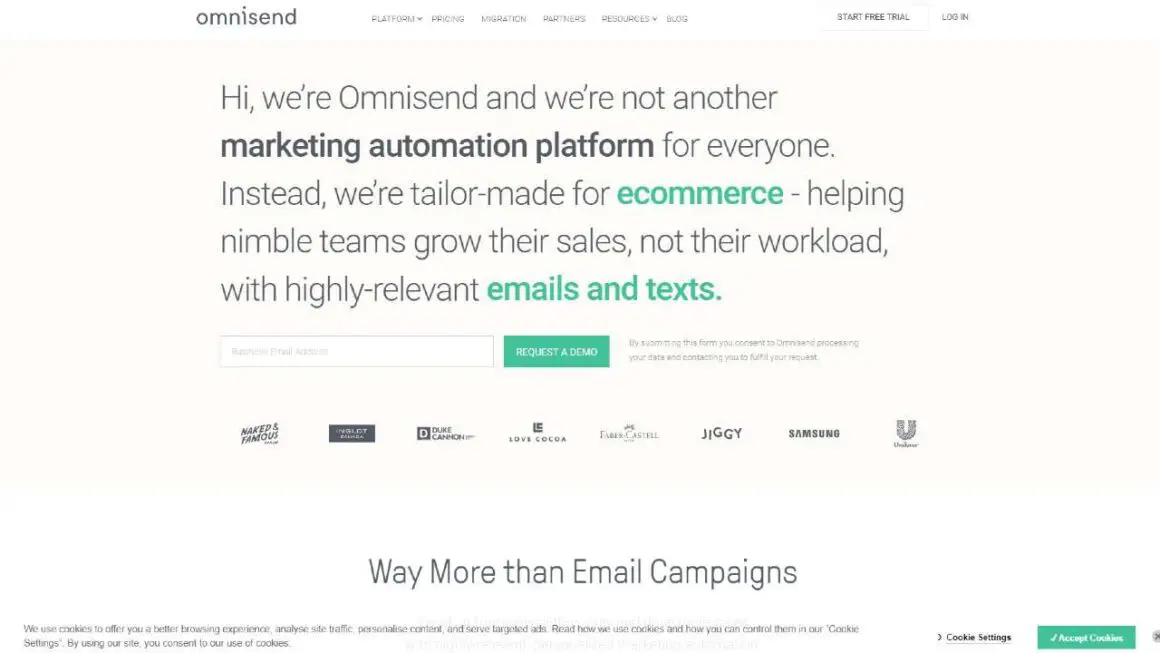
With Omnisend, email marketing is taken a step further by combining email marketing across social media platforms, text, WhatsApp, push notifications, and many more. 40,000+ marketers use their email marketing software in over 130 countries.
For e-commerce brands, Omnisend can send more relevant messages across platforms and devices to visitors. This is achieved by understanding website browsing behavior and user device preferences based on any custom events that you make.
For instance, you can track user actions on your website and then again within abandoned cart emails, welcome emails, and post-purchase automation series to segment messages more efficiently.
And they combine with all of the top ecommerce platforms.
Whether you’re using BigCommerce, Shopify, WooCommerce, Magento, or any other e-commerce software, you can hook up Omnisend to drive more sales.
You can send 15,000 emails/month and get access to their automation features with their $16 per month Standard Plan. These include SMS notifications, interactive signup forms, and email elements, and product recommendations.
This feature set is superb for e-commerce conversion rates as users will receive messages based on the products they’ve interacted with on your site.
Omnisend is one of the best picks for omnichannel brands who want to effectively market (and remarket) to their visitors.
A free 14-day trial has been made available. Their plans start at $16 and reach $99 when billed monthly. Their Enterprise plan has custom pricing and it includes features like unlimited emails per month and free SMS credits (which is new).
6. Gist
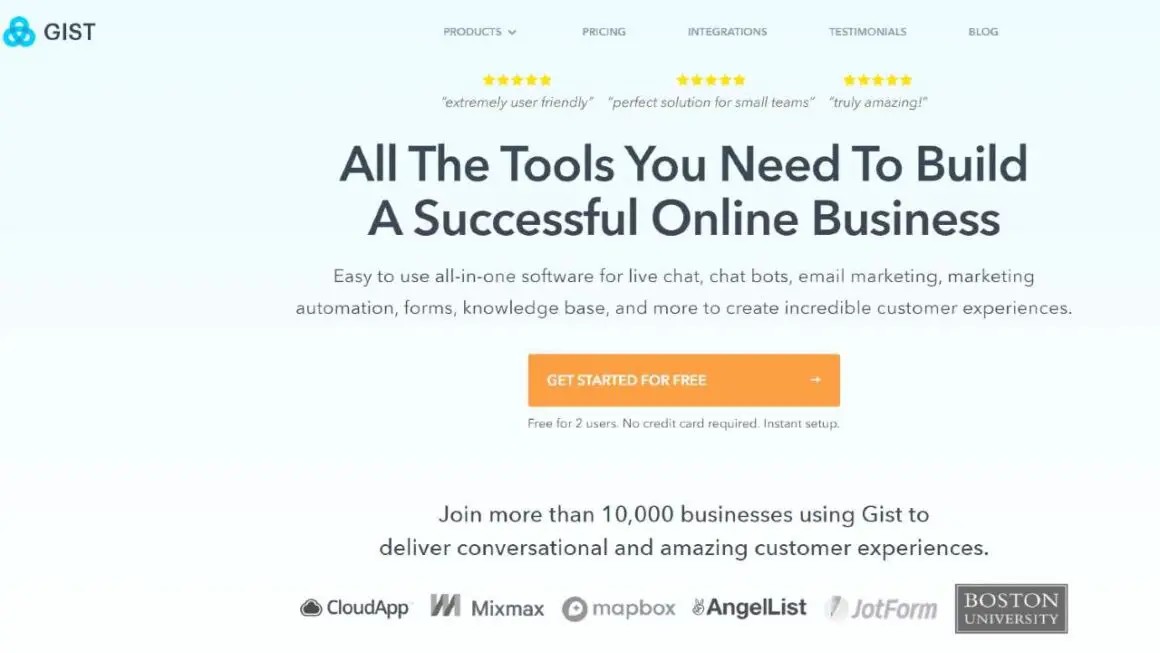
Gist is an email software, marketing automation, and live chat software that provides a full all-round view of your business.
They also feature elaborate tools like a knowledge base to provide customer support in an automated way as well as event tracking to see what people do on your website.
Where Gist really stands out is via their chatbot features. Their GistBot pre-qualifies leads and book meetings all day for your sales teams – all with a modern feel and in any language. You send private notes, assign conversations to different members of your team, and organize your conversations with easy open/close statuses.
Furthermore, their automation tools let you create visual workflows to attract and convert customers. It is possible to make actions and tags to understand customer behavior, segment your audiences, and use timing variables to send the right message at the right time.
For businesses looking to increase leads for their sales team, Gist is a great all-in-one marketing solution with advanced live chat, event management, and marketing automation.
You can get started for free and then upgrade to their Professional plan or Premium plan which are $29 and $99 respectively (all billed monthly).
7. Automizy
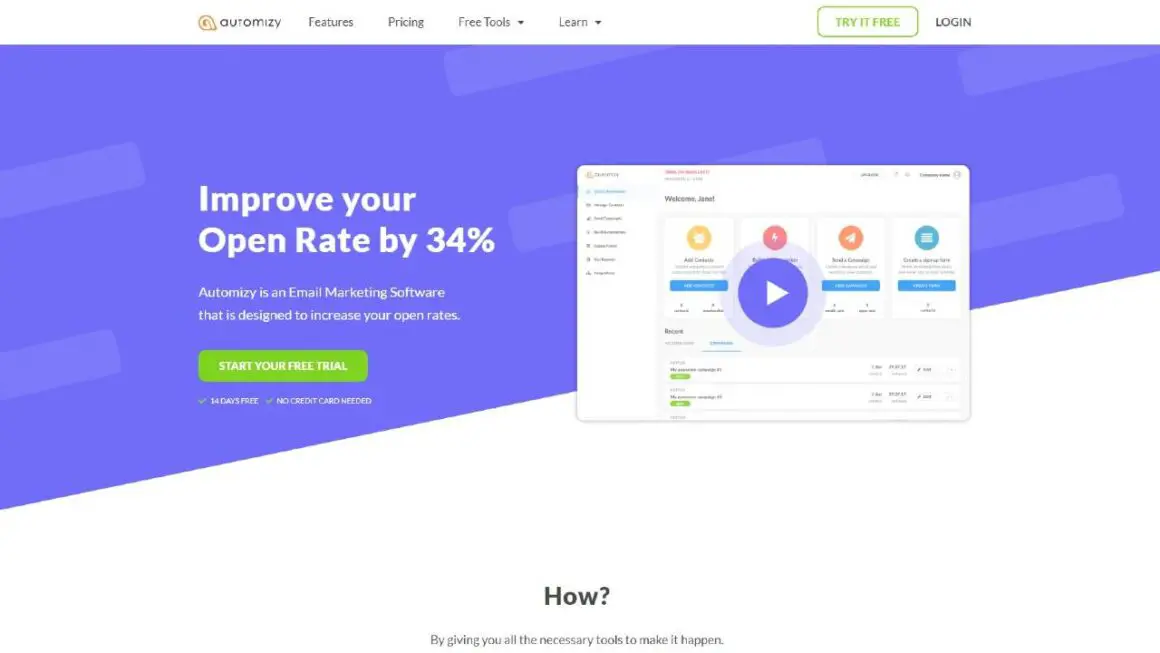
Automizy is an email marketing platform that is configured to increase your open rates by giving you all the much-needed tools to make your emails outstanding in a crowded inbox.
It supplies the crucial email marketing feature set that includes sending campaigns, creating forms, building automation, managing your contacts.
You’ll get all you need to reach your email marketing aims, all in one intuitive interface.
When using Automizy, you’ll gain access to proven email marketing best practices to help you increase your open rates with built-in best practices, save time with email templates and automation blueprints, create email automation, automatically resend campaigns to non-openers.
It also provides an email subject line tester to maximize your email open rates, so you can get scores for your subject lines before sending them. This feature helps to forecast subject line performance based on data from over 1 million campaigns.
Finally, automated emails can be AB tested. Write up to 4 subject line variations and sit back, let the AI optimize.
Get started with $9/month and you get access to all features including the user-friendly email workflow builder to map your best-converting email sales funnel.
8. AWeber
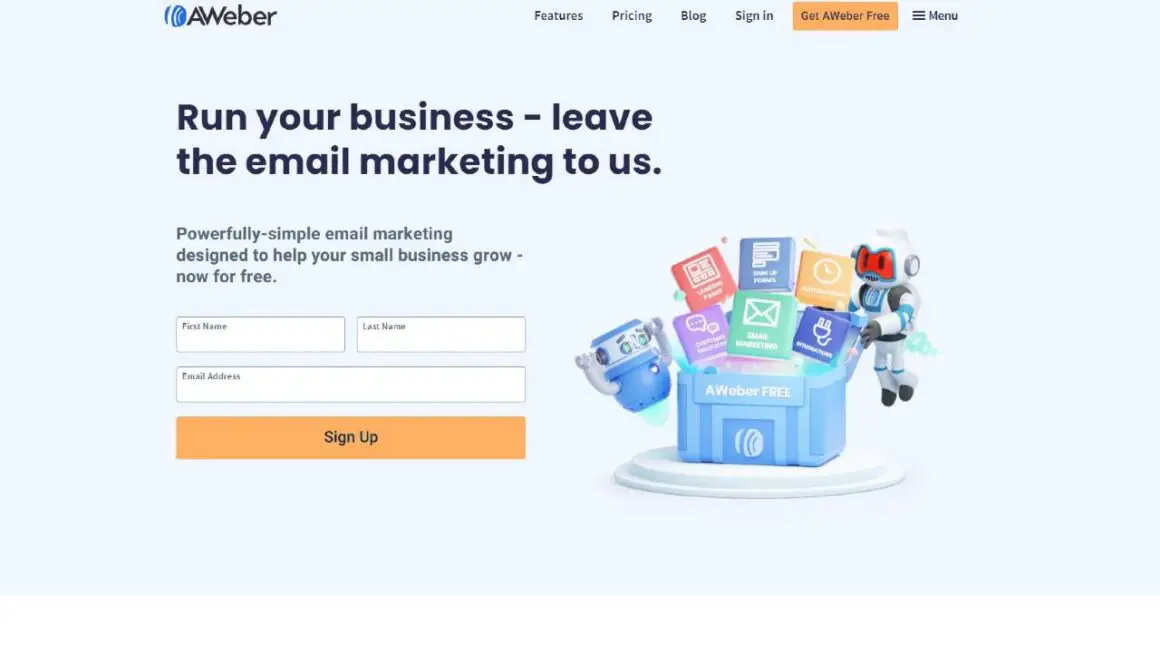
100,000+ email marketers use AWeber with features best suited for small businesses. With high-quality phone and email support, plus helpful support articles and videos, you get answers quickly and can focus on growing your business.
Just like the other tools discussed on this list, they offer drag-and-drop email builders, list management tools, and analytics reports.
With the list management feature, you can import an email list and create a database from common file types like TXT, CSV, XLS, XLSX, and TSV.
They make it quite simple to manage your lists with any rules you create automatically. Furthermore, with their marketing automation tools, you can create an autoresponder workflow based on actions like email opens, link clicks, site visits, and purchases.
Their 700 design templates is one selling point – this compares to 500 with GetResponse and just 80 with MailChimp. Although some of their templates look outdated, there are some that also look modern.
They also just made available the ability to use web-fonts in addition to standard fonts.
One downside is their reduced email deliverability rates, coming in 10-15 percentage points lower than other platforms on this list.
Generally, with the sheer amount of template designs, helpful support team, and knowledge base, Aweber is an excellent pick for small business owners.
Want to begin? You will have to sign up, pick one of their paid plans starting at $19/month and you will get one month free. Plus, you can save 14.9% when you pay yearly.
9. Mailchimp
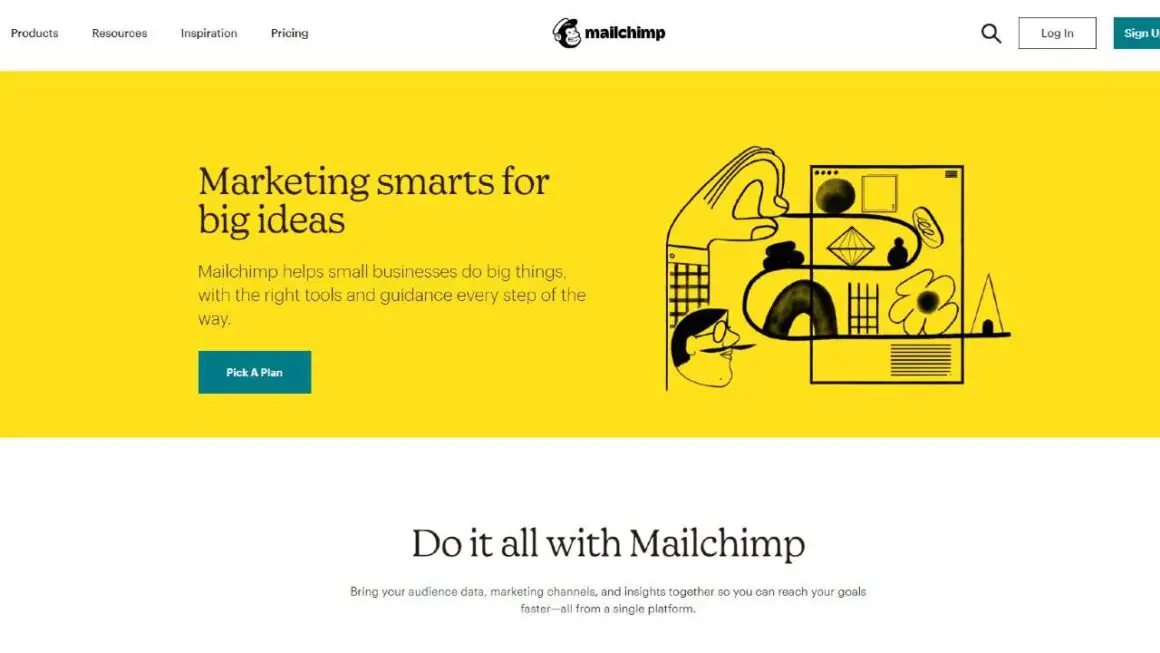
MailChimp is one of the famous names in email marketing with over 1 billion emails sent every day on their platform and over 14 million customers as of 2017.
They offer a free plan that gives users a user-friendly interface and up to 2,000 subscribers and 12,000 email sends per month which is more than enough if you’re a small business.
Their free plan includes analytics, autoresponders, transactional emails, and lots of third-party integrations. There’s a free Mailchimp app too for Android and iOS.
You will be charged based on the size of your email list, so if you go over the threshold of 2,000, you join their 2,000-2,500 plan at $30/month.
Generally, MailChimp may be the most popular free email marketing service on the market, with over 17 million users as of a few years ago.
However, they are listed here as they are quite popular and everyone uses them, although there are tons of other good options that can create more customized emails.
If your needs are rudimentary and you want one of the more basic options, give MailChimp a shot.
10. MoonMail
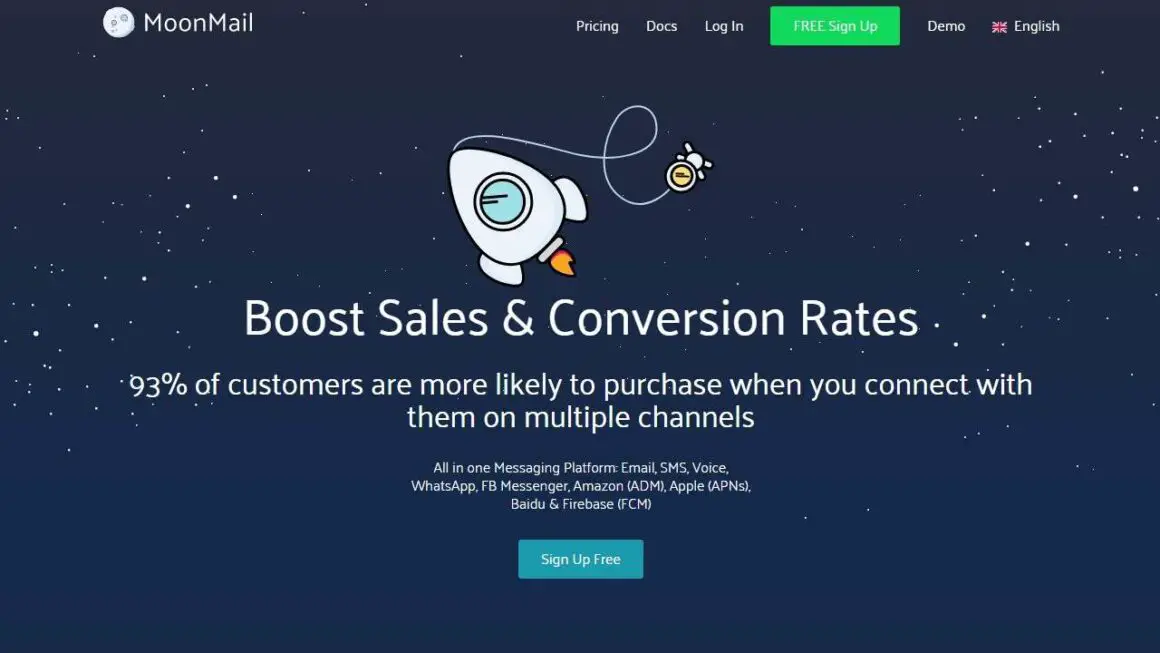
MoonMail is a cloud-based email marketing tool that works with Amazon AWS. They are an incredible omnichannel choice and can send messages through Voice, email, SMS, WhatsApp, including Facebook Messenger, and chatbots.
This type of event-based communication is brilliant for advertisers hoping to grow their outreach outside of email.
In the same way as other different tools on this rundown, they have a drag-and-drop editor and templates. One reward is their intuitive email headers. With HTML and CSS, you can change ad characteristics like menus, fades, color changes on hover, opacity changes, and many more.
Besides, they give incredible client support and a solid information base to help with regular inquiries.
MoonMail’s free plan is really restricted. It gives you up to 2,000 recipients, and one campaign to send every day, except you can only send to 10 recipients for each campaign.
Nonetheless, a major selling point is that they permit clients to just pay for emails sent versus based on the number of subscribers on your rundown.
Your smartest choice is to use their $23.99/month Starter Plan. This plan permits you to save up to 25,000 subscribers in your email list, and boundless campaigns and email to send every month.
It likewise gives automated email bounce management, compliance tracking, spam reports, automation, and premium help.
Their open API lets you send messages through WhatsApp, Facebook Messenger, or other different chatbots.
They additionally have a local Shopify application that helps e-commerce merchants send autoresponders and relinquished cart emails to prospective clients.
For advertisers and small businesses hoping to send more dynamic and interactive emails and use APIs to extend their range, MoonMail is a decent pick.
You can begin with a free MoonMail account to try out their features and move up to their $23.99/month Starter Plan.
What is email marketing?
A straightforward email marketing definition is the utilization of email to promote products or services. Even better, email marketing is an approach to utilize email to sustain and create associations with your email subscribers to complete an ultimate objective like a sale.
Email marketing is just one type of digital marketing, which also incorporates things like search engine marketing, social media, Search engine optimization, blogging, and so on.
Prior to email, post office based mail was an approach used to reach consumers in their mailbox. Email marketing takes this procedure online by sending messages to clients electronically to their email inbox. In contrast to direct mail, email requires a client to opt-in to your email list to receive your messages.
How does email marketing software work?
Email marketing software (or e-mail marketing) is utilizing online stages to convey bulk marketing email messages to your list of subscribers. This strategy allows you to get new customers better, enhance relationships, and encourage customer faithfulness.
With email marketing campaigns, you can rapidly and easily contact your audience exactly where they are without paying for costly publicizing space on Google or Facebook.
The best email marketing software works by utilizing some of these fundamental features:
1. Dynamic content
You can utilize merge labels in your emails to customize them for each member of your email list, by dynamically changing.
2. Automation
The capacity to send email sequences when a client joins your mailing list or performs an action on your site. This could include making a purchase or leaving their shopping cart.
3. Advanced highlights
Look out for other cool highlights to add to your campaigns like polls, contests, coupons, and occasions.
4. List segmentation
The more you engage with your email list, the more data you gather, including open rates, interests, purchase history, and more.
5. Analytics dashboard
Including open rates, click-through rates, purchases, and so on.
6. Custom email templates
Drag-and-drop email campaigns remove the coding requirements from email marketing so you can concentrate on adding content and images to your emails.
Advantages of email marketing platforms
At the point when a user opts-in to your email list, they have shown enthusiasm in your business and are prepared to get your messages. Since 74% of purchasers identify word of mouth influencing their purchasing decisions, email is a natural extension of that ability to gather and share information that is important to them.
Also, if you’re in sales, email is the third most persuasive source of information for B2B audiences behind only personal workplace connections and recommendations marketing is essential because it is one of the ideal ways to build a dedicated following and generate income from industry thought leaders.
By picking the best email service, you cost-effectively send messages at scale, address warm leads without cold email outreach, and don’t pay a fee outside of your monthly subscription.
Additional advantages of using email marketing services:
- Email marketing is cost-effective and has a proven ROI (each dollar spent can make a $44 return on investment)
- Convenient and pre-designed email designers make creating spectacular and mobile-friendly emails a breeze
- Email is one type of multi-channel marketing that builds client loyalty and brand awareness
- You reach your customers precisely where they are – their inbox
- Email permits marketers to contact their audience with applicable, customized, dynamic messages – 74% of marketers say personalization increases customer engagement.
- Automated emails like welcome emails, abandoned cart emails, and post-purchase emails permit you to produce gradual income with little work or time required
- Email marketing options are endless and you can discover easy-to-use tools whether you’re a small business or large enterprise.
Email marketing best practices
Email marketing isn’t as straightforward as composing a message and sending it to a list of contacts. There are tons of email marketing best practices to follow and email marketing industry standards to hit.
Some of them are:
1. Do not utilize purchased email lists
Email marketing is so effective in light of the fact that individuals want to engage with your business and receive your message. Purchasing email lists removes this trust by spamming their inbox with something they don’t want.
Plus the penalties for not following these guidelines are severe. According to Keap (which was formerly called Infusionsoft), you can be fined up to $16,000 per incorrect email under the CAN-SPAM Act.
The soundness of your email campaigns depends on a healthy open rate. If you are interacting with a purchased list, you will undoubtedly have super-low open rates, spam complaints, and can even be blacklisted.
Once again, never purchase email lists! You should likewise clean your email list frequently to confirm your contacts are up to date.
2. Personalize content with merge tags
An email titled, “Dear {first name}” is much more personal and acceptable than “Dear Member.” Note that any piece of data that you gather from your email subscribers should be used to personalize the content you send to them.
A merge tag will do just fine if the item fits in a column within a CSV file next to their email address. A merge tag is a piece of ESP-specific code that permits you to place unique pieces of user data from your email list into your emails.
First and last names are the most well-known merge tags at an email marketer’s disposal. Furthermore, you can utilize other cards like company name, date of the past visit, the quantity of emails opened, products purchased, or information from a survey.
Utilizing merge tags in your initial greeting is a great place to start making your email more personal.
3. Write convincing subject lines
Email subject lines should be brief, convincing, and create a sense of urgency while providing enough information, so the user knows what they are opening. Sound confusing? Don’t worry, it isn’t.
Subject lines ought to be between 30 and 50 characters (many email providers cut off subject lines more extended than that). They should cut through the noise and lure users to act. The use of numbers and symbols, reasonable emojis, and exciting offers and discounts will increase your open rates.
4. Utilize a welcome email series for new subscribers
Email automation is an incredible tool most often used in a series of emails that welcome new subscribers into the list. These are free autoresponder emails sent automatically to new users when they opt-in to your list.
You can time these emails so that your subscribers get them at stipulated times. Only you know the correct pace for these emails based on your business objectives.
For instance, an e-commerce website may offer a 10% discount on the first welcome email. For emails 2 and 3, they can additionally showcase their product catalog, brand story, and social media accounts. A welcome email series is wonderful because it runs on autopilot, engages your list, and nurtures prospects into customers.
5. Format your emails appropriately
Emails ought to be between 500 and 600 pixels wide- any wider than that and users may have to scroll horizontally on their mobile devices.
Never make your “from” email address a “no-reply” email, like noreply@abc.com. Make it a name your subscribers will instantly identify.
Place your primary marketing message and call to action (CTA) above-the-fold so that most of your users will see it right away.
In your email content and imagery, adhere to three fonts or less, and ensure the design matches the look and feel of your brand. Finally, your logo should be at the top of the email so that subscribers will recognize your brand at first glance.
FAQs
What are the types of email marketing?
There are three primary types of emails you can send to your list:
- Newsletters and marketing emails: These are emails that are sent one time to your list and provide up-to-date content, offers, and news.
- Transactional emails: These emails are utilized in eCommerce and could be for order confirmation emails, invoices, receipts, and shipping confirmation emails.
- Behavioral emails: These are emails that are triggered based on subscriber activities, such as welcome emails when a user joins your list, post-purchase review emails, re-engagement emails upsell/cross-sell emails, or free trial expiration emails.
Can I do email marketing for free?
Of course, you can get free email marketing software if you have a small list size. For instance, Mailchimp offers free plans if you have less than 2,000 contacts and only need to send 10,000 emails per month.
Notwithstanding, there are other well-known tools that have better deliverability, more exclusive designs, and more automation features. You get what you pay for.
How do I do email marketing?
To begin with email marketing, you need to follow these steps:
- 1. Pick an email service provider from this list and sign up.
- 2. Accumulate contacts via opt-in forms to develop your email list.
- 3. Create your initial email templates.
- 4. Create your welcome email series.
- 5. Use one of the best grammar checkers to make sure your content is free of blunders.
- 6. Perform A/B testing on your subject lines to improve open rates.
- 7. Preview your email in the platform to make sure that it looks across all devices.
- 8. Schedule and send your emails at your own chosen time.
- 9. Review your email analytics in order to improve your engagement.
When is the best time to send an email?
The timing of your email sends depends on the customer data with you and your business type.
For instance, Tuesdays and Wednesdays tend to have the best engagement, with more people apt to open, read, and click your emails. Likewise, 8 am and 4 pm tend to be the best times of the day to send email messages.
How do I optimize email campaigns?
To enhance your emails and improve engagement, you need to conduct A/B testing and view analytics reports to increase your numbers.
You should always test each variable in turn to understand how your data reacts. For instance, you can conduct a test on the time of day, email subject lines, the imagery used, customer segment, the content of the email, and the call-to-action.
Summary
That is all. I hope this list of top email service providers assists you in picking the right platform for your online business.
As there are a number of great tools out there, it’s ultimately about knowing your price point and which features are most important to you.
Concentrate on price, deliverability, template designs, ease of use, and the unique features you need.
What do you think about this list? Are there any other platforms that you think should be on this list? Let me know in the comments section. Cheers!
